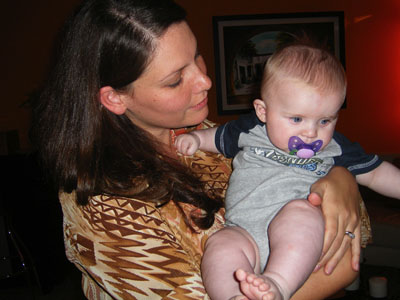Flowood, Miss.—After having her first baby, Risa Nakase-Richardson of Flowood expected to experience sleep deprivation, stretch marks or maybe even a bout of postpartum blues.
But deQuervain’s tendinitis?
The painful condition is caused by tendon inflammation along the thumb side of the wrist, and Richardson was surprised to learn that it’s as common as undereye circles among new moms.
“All my friends with babies have been telling me war stories,” said Richardson, a neuropsychologist for Methodist Rehabilitation Center in Jackson, Richardson believes she got hurt hefting her son Wyatt into a car seat each day, a task that also took a toll on her shoulders and back.
“If you think about it, baby equipment today is not built ergonomically for parents,” she said. “I had to lift a 20-pound infant in a 10-pound seat into a tall SUV with my wrist. That’s a formula for pain.”
Pregnancy and parenthood can be a precursor to a number of physical ailments, which is one reason Methodist Rehab recently launched a program that focuses on feminine issues at its outpatient rehabilitation center in Flowood, said physical therapist Susan Geiger.
“Sometimes women get so caught up with the demands of motherhood that they don’t realize that there are therapies available for postpartum problems such as tendinitis, stress incontinence or chronic shoulder, back or pelvic pain,” Geiger said. “We’re hoping this new emphasis will encourage moms to take care of themselves, too.”
Program staff also hope to help expectant parents by preaching injury prevention. Geiger said a good first step would be to make equipment purchases with an eye toward ergonomics.
“When we shop for nursery equipment, we often focus on safety features for the baby or whether the style will fit with our decorating scheme,” Geiger said. “But I tell parents to also look for cribs and changing tables that are appropriate for each parent’s height. When you’re lifting your infant, it’s best to have the baby’s weight at waist level.”
Keeping that weight close to the center of your body is another good pain-prevention measure, said Peggy Kelly, an occupational therapist at Methodist Rehab. While many women use their hands to pick up infants under their armpits, “that’s basically hanging the baby on your thumbs,” Kelly said. “A better strategy would be to run your arm through the baby’s legs and up his back and scoop him close to your chest.”
Hauling a baby in and out of a car also can be a recipe for a repetitive use injury. So if you’re in the market for a new mom-mobile, take a car seat along and give the process a trial run, recommend the therapists.
“If you’re a short person, an SUV might force you to do all your lifting at shoulder level, which is tough on your upper back,” Geiger said. “One of our petite therapists found she had better luck with a van because she could move her baby in and out of his seat while inside the vehicle.”
Geiger said another way to head off postpartum aches and pains is to condition your core muscles before getting pregnant. “Abdominal strengthening can help you get in shape for all the repetitive squatting, lifting and pushing that are part and parcel of parenthood.”
If life with Junior still leaves you injured, Geiger said physical and occupational therapy can generally help you recover quickly.
Richardson turned to staff at Methodist Rehab’s outpatient clinic to help her over the hump. An injection to reduce inflammation and pain and the addition of a custom splint relieved her wrist woes, while soft tissue manipulation, stretching and electrical stimulation alleviated the aches in her shoulder and back.
“I’m lucky I work here and don’t have to live with pain,” she said.
Tips for Toting Tots
- Use a half-kneel lift to pick your child up from the floor. Stand close to your child and lower yourself to one knee while keeping your back straight. Once down on the floor, grasp your child with both arms and hold him close to your body. Tighten your stomach muscles, push with your legs and slowly return to a standing position.
- Always hold or carry your child clutched closely to the center of your body. Avoid balancing your child on one hip. When using a child carrier, keep your back straight and shoulders back to avoid neck and back strains.
- When pushing your child in a stroller, stay close and keep your back straight and your shoulders back. Push with your entire body, not just your arms. Also avoid pushing the stroller too far ahead because that may cause you to hunch your back and shoulders.
Source: American Physical Therapy Association
Methodist Rehabilitation Center is one of only 16 hospitals in the country designated as a Traumatic Brain Injury Model System by the National Institute on Disability and Rehabilitation Research and is only one of two in the state accepted into the prestigious Council of Teaching Hospitals. It is also the only hospital in the state to be named one of America’s best by US News and World Report.

